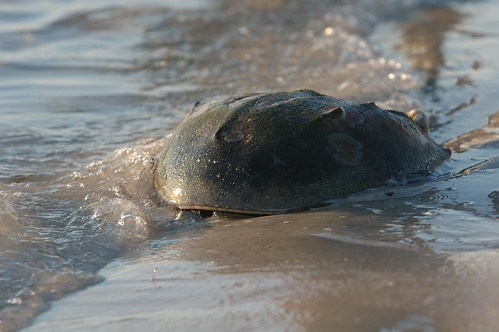Horseshoe Crabs Begin Migration onto Atlantic Coast
Citizens Can Help Scientific Survey of Ancient Creature

Maryland DNR photo
The annual spawning migration of horseshoe crabs – Limulus polyphemus – is now returning to Maryland beaches. The peak of the horseshoe crab spawn depends on late spring and early summer high tides, culminating on or around each full and new moon in June. Dating back an estimated 350 million years, this yearly event along the Atlantic coast is thought to be the world’s oldest and largest wildlife migration.
Biologists from the Maryland Department of Natural Resources (DNR) monitor the returning horseshoe crab population for ecological and scientific research purposes. The department encourages the public to report any spawning activity and sightings of horseshoe crabs to DNR’s Horseshoe Crab Volunteer Angler Survey.
On average, one spawning female horseshoe crab will deposit 20,000 eggs into the sand.
Horseshoe crab eggs are a natural part of the diet for migratory shorebirds preparing to return to their summer nesting grounds in northern Canada. Horseshoe crab larvae are also an important food staple for juvenile Atlantic loggerhead turtles, as well as striped bass, American eel, and flounder.
The horseshoe crab’s blue, copper-based blood is critical for biomedical research — the animals are collected by specially permitted fishing operations, have blood drawn in a biomedical facility, and then are released back into the water.
Despite their menacing armor and tail, horseshoe crabs are gentle creatures that do not bite or sting. The tail is not a weapon but is used to plow the crab through the sand and muck, to act as a rudder in the water, and to right the crab when it accidentally tips over. They can only survive outside of water for a short amount of time.
